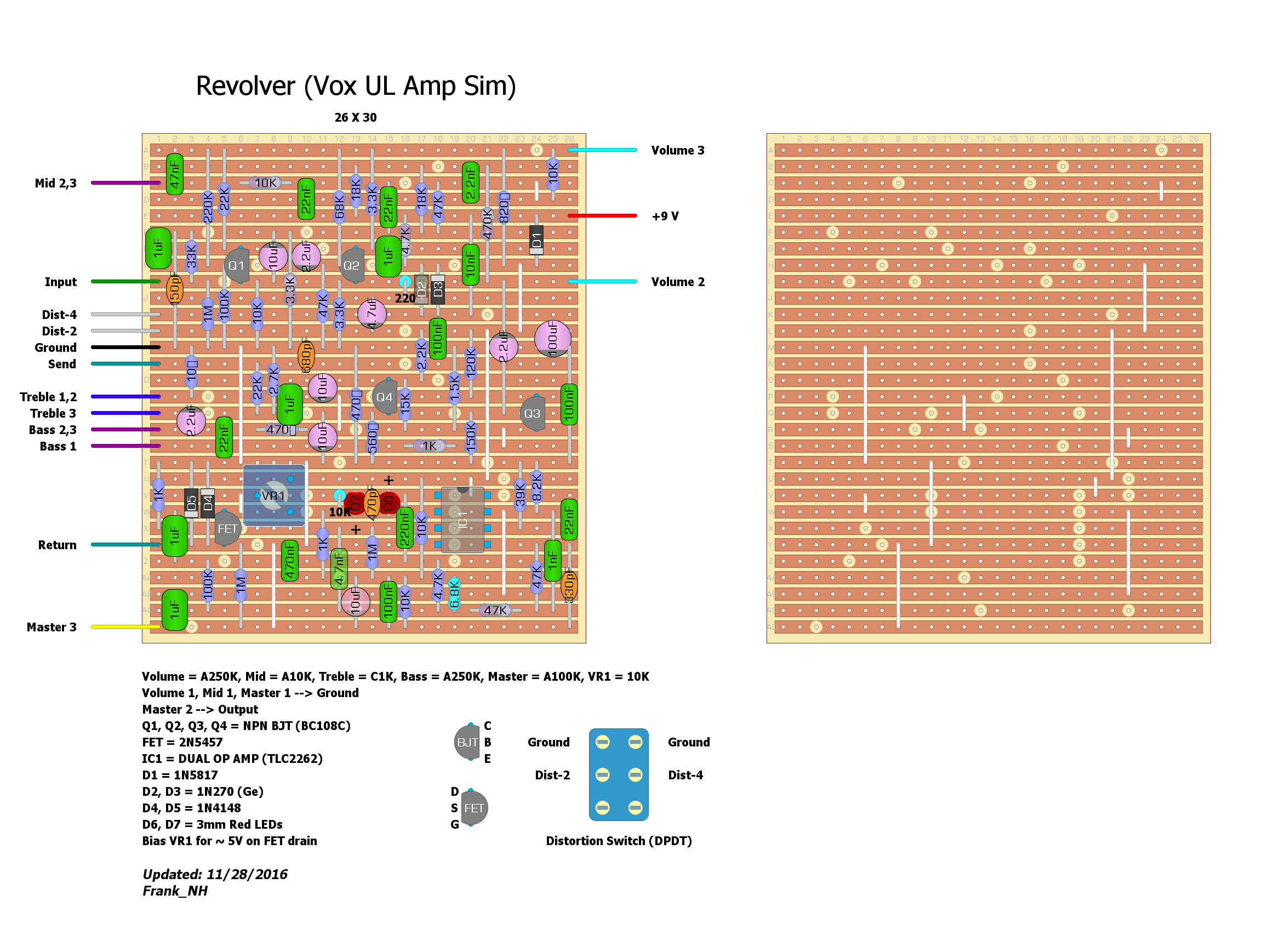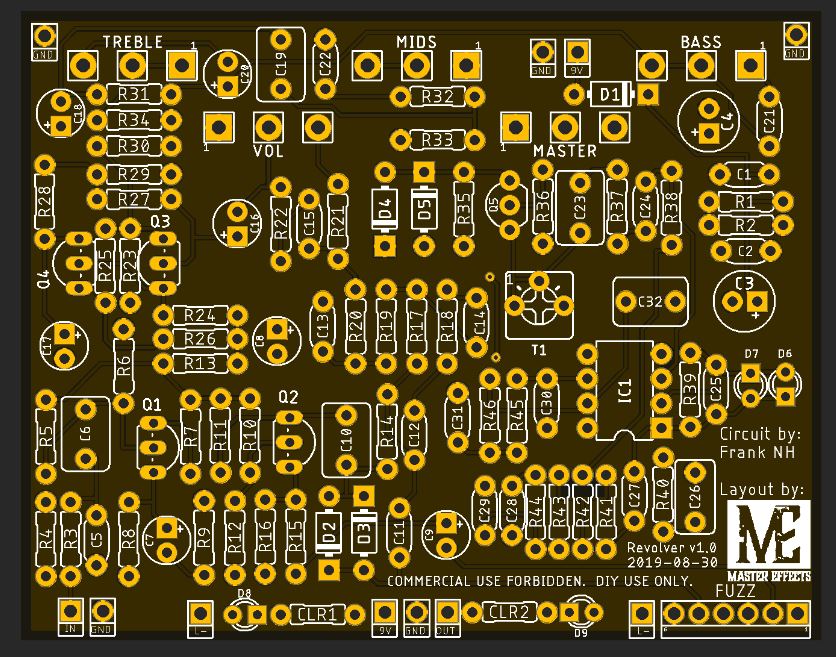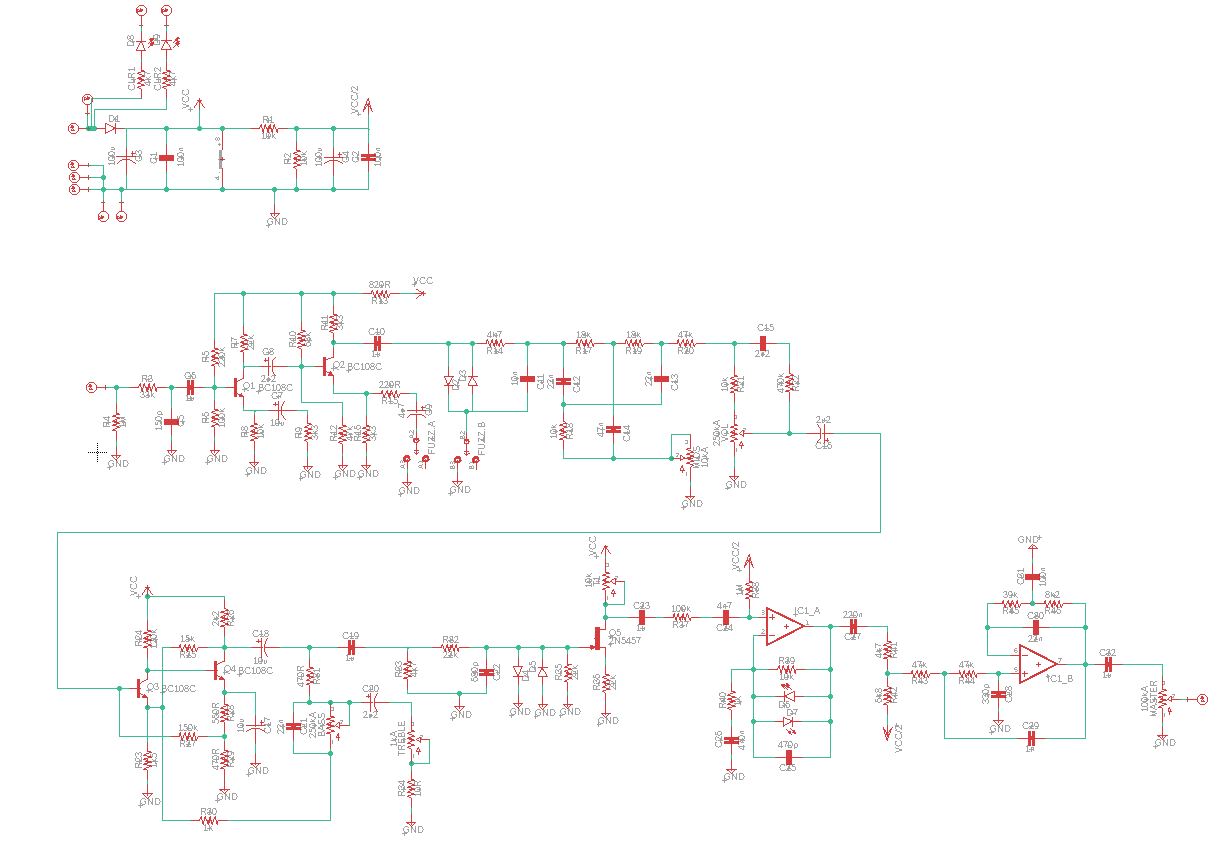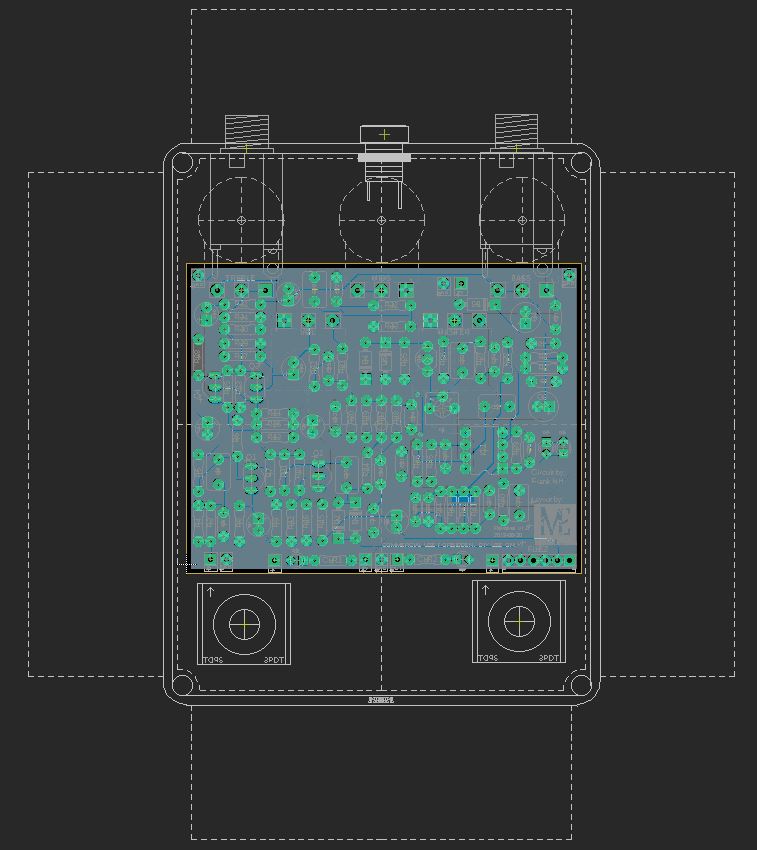Revolver - UL Amp Sim
12
12
|
This post was updated on .
Hey all,
I'm back with a special project that I've worked on over the past three years and now wish to release to my friends here at Guitar FX Layouts. It a simulation of the famous Vox UL series of amps, made famous by the Beatles on their album "Revolver". I originally code-named this project "Dr. Robert" but have since come to find out that there's a commercial pedal out there with this name (another UL amp sim), so I renamed it "Revolver". I don't think it will cause any confusion. I'm releasing the circuit with a full schematic, courtesy of the DIY Layout Creator - what a great application! So if anyone wants to create a PCB for fun, feel free. Some background on the amp is in order. Many know the story, but in the Fall of 1965, Dick Denny, designer of the legendary Vox tube amps, traveled to California to examine some new and innovative amps being developed by Vox’s new American partner, the Thomas Organ Company. These amps were unique for the time in that they used transistor preamp and power amp stages. Transistors themselves were relatively new to the electronics scene, but offered the promise of greater reliability and lower power consumption versus existing tube amps. The higher power designs that Dick Denny observed would later be marketed in America as the Viscount, Westminster, Buckingham, Royal Guardsman, and Super Beatle. Lower power designs were also developed and were released as the Pathfinder, Pacemaker, Berkeley, and Cambridge. One of the novel design features of the Thomas Organ amps was their modular construction. A common transistor-based preamp stage was fed into power amp stages of various output levels, making development and manufacturing of a range of amplifiers much easier. Tremolo and reverb were included on most models, along with a “distortion” (fuzz) option, thus beginning the trend of incorporating more onboard effects into amplifiers. Thomas Organ later developed the modular idea to point that the amp models shared the same printed circuit board, with specific features included or excluded based on the model being produced. While the new modular designs were attractive and forward thinking, Dick Denny was hesitant to make the power stage fully transistorized. Thus, in early 1966 Vox came up with hybrid, modular designs which eventually became the legendary UL series amps (also known as the “7” series amps due to the numbering of these amps in the Vox lineup). The UL amps had solid-state preamp stages, including tremolo, vibrato, and distortion, but the power amp stages were all separate tube designs. Vox provided the Beatles with these amps for their 1966 album "Revolver" and the rest, as they say, is history. The guitar tones on that album and the accompanying singles "Paperback Writer" and "Rain" are legendary. My goal in developing this circuit was to be faithful to the original topology as much as possible. To that end, I basically converted the original transistor preamp to run at 9V pedal power. To assist me in this, I used LTSpice to simulate the original circuit and then the pedal circuit. There were inevitably some compromises along the way but the preamp part of the resulting circuit is very similar (or identical) to the original. Now, part of the magic of the UL amps versus their American cousins (the Thomas Organ amps) was the all tube power amp stage. So in order to recreate the crunchy tube tone at high gain, I adapted the ROG Britannia's "power amp" part of that circuit for this project - basically a soft-clipped op amp stage with some tone filtering. The result? The transistor preamp pushes the soft clipped op amp stage to create nice overdriven sound, and it reminds me a lot of the lead guitar tone in the Beatles single "Paperback Writer". I also included a distortion switch which mimics the original amp's onboard "fuzz". I tried to get a similar sound, but alas it sounds more like heavy distortion. You can play around with the diodes to suit, or just remove this altogether. You may have noticed that there are send/return connections - a simple "effects loop". I put that into the circuit as I was planning to make a "super pedal" by putting a tremolo and reverb in this effects loop so as to produce a full simulation of the amp (which was equipped with both tremolo and reverb). I tested this using the Colorsound Tremolo and the Rub-a-dub Reverb circuits, and it sounded quite convincing. However, in my prototype (pictured below) I did not use it. Just solder a wire connecting the send and return if you don't want to use it. The controls are straightforward and amp-like. The Volume acts like a "gain" control and will kill the sound if rotated fully off. The master volume was incorporated to adjust overall level. The Bass and Treble controls work as you'd expect, and the Mid control gives you a HUGE mid frequency notch that sounds very cool! As you can see, I have built a prototype and it works fine. In fact, I've built this twice (my second board is for my build with the tremolo and reverb). However, there always a chance there's a bug in the vero layout so I will pronounce this verified by me but if someone else builds it successfully, then it will be officially verified! Have fun with this project, and let me know if there are questions. 
|
|
Here is the schematic.

|
|
Here are pictures of the prototype (complete with the crude, hand-drawn labeling - code named "Dr. Robert"
 ). ).
  
|
|
Thank you Frank, for the hard work.
This will go on my ever-growing list. |
|
In reply to this post by Frank_NH
http://www.dedalofx.ar/bioroids/circuits/c03_moscato_fuzz.php
Have you seen that project, Frank? Lately I was looking for a beatles box simulator for a guitarplayer friend, do you have some sound sample from your Vox sim? Thanks a lot, seems a great project too |
|
Hi Sergio,
I hadn't seen the MOScato fuzz before, but it looks pretty cool, and is a pretty simple design. Perhaps someone should make a vero layout of that. My circuit was an attempt to be pretty faithful to the original design (at least in the preamp). As I was developing the citcuit on the breadboard, I researched YouTube demos of existing UL amps. The key seems to be pushing a tube power stage with the transistor preamp. Since we're not using tubes, I used the Britannia's soft-clipped output gain stage to simulate a tube power stage tone. I'll put up a link to some demo's soon (once I record them). 
|
|
fantastic. when i was a kid Paperback writer was my favorite riff and still one of my favorite tones! The very first pedal I made was a Vox Tonebender! I was told they used a Vox tonebender on that song. So its an onboard Fuzz not a Vox Tonebender
|
|
Does it have a nice edge to it? I just lisetened to Rain its a great edge on the tone.if you give me the exact drill ho;e measurements ill make a vox grill cloth decal for ya
|
|
Here's a link to a video of the pedal I uploaded to Vimeo. Apologies for my clumsy playing in "A" with a backing track (courtesy my Digitech Trio pedal) but I wanted to demo the high gain sounds you can get. The Boost switch gives you a near fuzz (more smooth and not as gated like some fuzzes). Anyhow, hopefully this gives you an idea of the sounds.
Frank (Yeah, the enclosure is amateurish, but hey it's a prototype!  ) )
https://vimeo.com/327649837 |
|
Sounds good Frank, thanks for the demo
|
|
A couple of comments on the video.
It was taken with my old iPhone so sound quality is mediocre (compressed). The guitar was my trusty Telecaster with p-90s, the bridge p-90 being used throughout the video. The amp was my Blues Cube Artist, clean channel, 12" speaker, flat EQ, on the 0.5W setting, a little reverb and presence. The pedal can get very loud if you turn up the Master Volume. Also, being amp-like, you need to adjust the Master Volume to suit the gain (volume control, boost switch) and EQ. The Mid control should be full up to remove the mid notch - but that mid notch DOES sound cool with the fuzz boost! 
|
|
Hi guys,
I took Frank's circuit (with his blessing) and made a PCB layout for it. Designed for a 1590BB enclosure with top mount jacks and DC power, board mounted LEDs and PCBs (because offboard wiring is the bane of my existence :)) The PCB is unverified but i have high confidence that it should be good. If you want to try building it, i will figure out how to attach a zip file with the gerbers and BOM so you can order your own boards. I'd recommend JLC PCB - you can get 5 good quality boards for $5US and i think you get free shipping if it's your first order.   
|
|
I'll try, how do i get the gebers? Thx
Ramirez |
|
working on getting a project up on oshpark. bear with me.
|
|
Thank you, boards in progress!!
|
|
Let me know how it goes! Very excited to hear.
|
|
has anyone had a chance to try it?
|
|
Waiting for the boards, keep contact Em seg, 7 de out de 2019 15:55, Sensei Tim [via Guitar FX Layouts] <[hidden email]> escreveu: has anyone had a chance to try it? |
|
Hello Tim and Emmanuel.
Thanks Tim for providing the Gerber files and Emmanuel for trying out the boards. I was going to order some as well but I've been a bit busy lately. Hopefully things will settle down and I can get back to effects building in the near future. I'll follow this thread to see if there any questions. I've built the circuit twice on vero so I know that it works. I'm also sure that someone could improve it by tweaking things here and there. cheers, Frank |
«
Return to Circuit designs
|
1 view|%1 views
| Free forum by Nabble | Edit this page |

